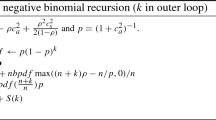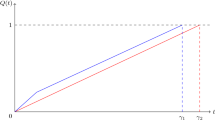Abstract
We consider the GI/G/1 queue where customers are served in random order and the service time distribution has a finite exponential moment. We derive the large deviations result for the waiting time distribution by showing that the asymptotic decay rate of the waiting time distribution is the same as that of the busy period distribution.



Similar content being viewed by others
References
Borst, S.C., Boxma, O.J., Morrison, J.A., Núñez Queija, R.: The equivalence between processor sharing and service in random order. Oper. Res. Lett. 31, 254–262 (2003)
Boxma, O.J., Foss, S.G., Lasgouttes, J.-M., Núñez Queija, R.: Waiting time asymptotics in the single server queue with service in random order. Queueing Syst. 46, 36–73 (2004)
Carter, G.M., Cooper, R.B.: Queues with service in random order. Oper. Res. 20, 389–405 (1972)
Flatto, L.: The waiting time distribution for the random order service M/M/1 queue. Ann. Appl. Probab. 7, 382–409 (1997)
Fuhrmann, S.W.: Second moment relationships for waiting times in queueing systems with Poisson input. Queueing Syst. 8, 397–406 (1991)
Kingman, J.F.C.: On queues in which customers are served in random order. Proc. Camb. Philos. Soc. 58, 79–91 (1962)
Palm, C.: Waiting times with random served queue. Tele 1, 1–107 (1957) (English ed., original from 1938)
Palmowski, Z., Rolski, T.: On the exact asymptotics of the busy period distribution in GI/G/1 queues. Adv. Appl. Probab. 38, 792–803 (2006)
Rolski, T., Schmidli, H., Schmidt, V., Teugels, J.: Stochastic Processes for Insurance and Finance. Wiley, Chichester (1999)
Takács, L.: Delay distributions for one line with Poisson input, general holding times, and various orders of service. Bell Syst. Tech. J. 42, 487–503 (1963)
Takagi, H., Kudoh, S.: Symbolic higher-order moments of the waiting time in an M/G/1 queue with random order of a service. Commun. Stat. Stoch. Models 13, 167–179 (1997)
Acknowledgments
The first author’s research was supported by Basic Science Research Program through the National Research Foundation of Korea (NRF) funded by the Ministry of Education, Science and Technology (2011-0004133). The second author’s research was supported by Basic Science Research Program through the National Research Foundation of Korea (NRF) funded by the Ministry of Education, Science and Technology (2011-0011887).
Author information
Authors and Affiliations
Corresponding author
Appendix: Proof of Theorem 1
Appendix: Proof of Theorem 1
For the proof of Theorem 1, we need a series of lemmas. Before presenting the lemmas, we need the following result which is used in the proof of one of the lemmas.
Lemma 2
Let \(X\) be a nonnegative random variable with finite mean and let \(X^{(e)}\) be the equilibrium random variable of \(X\), i.e., \(\mathbb{P }(X^{(e)}>t)=\frac{1}{\mathbb{E } X}\int _t^\infty \mathbb{P }(X>s) \mathrm{d}s\). If \(\underline{r}^X =\overline{r}^X\), then so is \(r^{X^{(e)}}\) and \(r^{X^{(e)}}= r^X\).
Proof
Since \(\underline{r}^X =\overline{r}^X,\mathbb{P }(X>t)=e^{-t(r^X+o(1))}\) as \(t \rightarrow \infty \). Then
This implies that
which completes the proof. \(\square \)
Now, we present a series of lemmas which will be used in the proof of Theorem 1. The first lemma can be found in Theorem 2.1 of Palmowski and Rolski [8].
Lemma 3
(Palmowski and Rolski [8]) Let \(\tau _{x,z}\) be the time interval from the time when the initial workload is \(x\) and the remaining arrival time is \(z\) to the time when the system is empty. If \(\theta _*<\theta _\gamma \), then we have for \(x >z \ge 0\),
where \(h(x,z)>0\) is given explicitly in [8].
The following corollary is immediate from Lemma 3.
Corollary 1
If \(\theta _*<\theta _\gamma \), then \(r^{\tau _{x,z}} = -\kappa (\theta _*)\) for \(x>z \ge 0\).
We note that Theorem 1 is alternatively written as \(r^G=r^{G_a}=-\kappa (\theta _*)\). In the following two lemmas, we show that \(r^{G} = -\kappa (\theta _*)\).
Lemma 4
If \(\theta _*<\theta _\gamma \), then \(r^{G} = -\kappa (\theta _*)\).
Proof
For \(x >z \ge 0,\,G\) is stochastically smaller than \(\tau _{x,z}\), i.e.,
By (1), there exist \(x\) and \(z\) such that
Then
By Corollary 1, (11) and (12), we have \(r^{G} = -\kappa (\theta _*)\). \(\square \)
Recall that we use \(\kappa ^{T,B}\) and \(\theta _*^{T,B}\) instead of \(\kappa \) and \(\theta _*\) when we want to represent the interarrival time \(T\) and the service time \(B\) explicitly. For the same purpose, we use \(\theta _\gamma ^{T,B},\,G^{T,B}\) and \(G_a^{T,B}\) instead of \(\theta _\gamma , G\) and \(G_a\).
Lemma 5
If \(\theta _*=\theta _\gamma \), then \(r^{G} = -\kappa (\theta _*)\).
Proof
If we let \(B^M=B \wedge M\) for \(M>0\), then \(\mathbb{P }(G>t) \ge \mathbb{P }(G^{T, B^M} >t)\), which implies
Since \(B^M\) is bounded, \(\theta _\gamma ^{T, B^M} =\infty \) and \(\hat{m}_{\!B^M}(\theta _\gamma ^{T, B^M})=\infty \). By Remark 1, we have \(\theta _*^{T,B^M}<\theta _\gamma ^{T,B^M}\). Therefore, by Lemma 4,
Since \(-\kappa ^{T,B^M}(\theta _*^{T, B^M})\) converges to \(-\kappa (\theta _*)\) as \(M \rightarrow \infty \), combining (13) with (14) yields \(\overline{r}^G \le -\kappa (\theta _*)\).
It remains to show that \(\underline{r}^G \ge -\kappa (\theta _*)\). For \(\epsilon \in (0, (1-\rho )\frac{\theta _*}{\lambda })\), let \({\widetilde{X}}_\epsilon \) be a nonnegative random variable with the complementary distribution function \(\mathbb{P }({\widetilde{X}}_\epsilon >t) = \epsilon e^{-\theta _* t},\,t \ge 0\), and assume that it is independent of \(B\). Let \(\widetilde{B}_\epsilon =B+ \widetilde{X}_\epsilon \). Then \(\mathbb{P }(G>t) \le \mathbb{P }(G^{T, \widetilde{B}_\epsilon } >t)\), which implies
Since \(\hat{m}_{\widetilde{B}_\epsilon }(\theta )=\hat{m}_B(\theta ) \left(\frac{\epsilon \theta _*}{\theta _*-\theta }+1-\epsilon \right),\,\theta <\theta _*\), we have \(\hat{m}_{\widetilde{B}_\epsilon }(\theta _*)=\infty \). By Remark 1, we have \(\theta _*^{T, \widetilde{B}_\epsilon }< \theta _\gamma ^{T, \widetilde{B}_\epsilon }\). From (15) and Lemma 4, it follows that
Since \(-\kappa ^{T,\widetilde{B}_\epsilon }(\theta _*^{T, \widetilde{B}_\epsilon })\) converges to \(-\kappa (\theta _*)\) as \(\epsilon \rightarrow 0+\), we get \(\underline{r}^G \ge -\kappa (\theta _*)\), which completes the proof. \(\square \)
In the remainder, we will show that \(r^{G_a}=r^G\). Let \(t_k\) be the arrival epoch of customer \(k,\,k=1,2, \ldots \). For the following two lemmas, we assume that a customer arrives at the empty system at time \(0\), i.e., the busy period starts when \(t_1=0\). By the discrete-time renewal reward theorem,
where \(N\) is the number of customers arriving during the busy period.
Lemma 6
We have \(\overline{r}^{G_a} \le r^G\).
Proof
This is trivial because \(\mathbb{P }(G_a>t) \ge \frac{1}{\mathbb{E }[N]}\mathbb{P }(G>t)\) by (16). \(\square \)
Lemma 7
Suppose that there exists \(\epsilon >0\) such that \(\mathbb{P }(T >\epsilon )=1\). Then \(\underline{r}^{G_a} \ge r^G\).
Proof
According to (16), we have
The second term of the right-hand side of the above can be written as
Therefore, (17) becomes
where \(G^{(e)}\) is the equilibrium random variable of \(G\). Finally, by using Lemma 2, we complete the proof. \(\square \)
To prove \(\underline{r}^{G_a} \ge r^G\), without the assumption of Lemma 7, let \(T_\epsilon =T {{\small 1}\!\!1}_{\{T>\epsilon \}}\) and \(\widehat{T}_\epsilon \) be a random variable with the complementary distribution function
We consider the GI/G/1 ROS queue with interarrival time \(T_\epsilon \) and service time \(B\). This queue can be thought of as a queue with batch arrivals where the batch interarrival time is \(\widehat{T}_\epsilon \), the batch size is geometrically distributed with parameter \(\mathbb{P }(T>\epsilon )\), and the service time is \(B\). If we consider one batch to be one customer, then this queue is the same as the GI/G/1 ROS queue with interarrival time \(\widehat{T}_\epsilon \) and service time \(\widehat{B}_\epsilon =B_1+B_2+\cdots +B_{\widehat{L}_\epsilon }\), where \(\widehat{L}_\epsilon \) denotes the batch size. It is not difficult to see that \(G_a^{T_\epsilon , B}\) has the same distribution as \(G_a^{\widehat{T}_\epsilon , \widehat{B}_\epsilon }\). Therefore,
from which and Lemma 7, it follows that
Since \(-\kappa ^{\widehat{T}_\epsilon , \widehat{B}_\epsilon }\left(\theta _*^{\widehat{T}_\epsilon , \widehat{B}_\epsilon }\right)\) converges to \(-\kappa (\theta _*)\) as \(\epsilon \rightarrow 0+\), we have the following lemma.
Lemma 8
We have \(\underline{r}^{G_a} \ge r^G\).
Finally, we are ready to prove Theorem 1.
Proof of Theorem 1
By Lemmas 4 and 5, we have \(r^G=-\kappa (\theta _*)\). From Lemmas 6 and 8, we obtain \(r^{G_a}=r^G\). Therefore, \(r^G=r^{G_a}=-\kappa (\theta _*)\), which is the assertion of the theorem. \(\square \)
Rights and permissions
About this article
Cite this article
Kim, B., Kim, J. Large deviations of the waiting time in the GI/G/1 queue with random order service. Queueing Syst 74, 431–443 (2013). https://doi.org/10.1007/s11134-012-9331-9
Received:
Revised:
Published:
Issue Date:
DOI: https://doi.org/10.1007/s11134-012-9331-9




